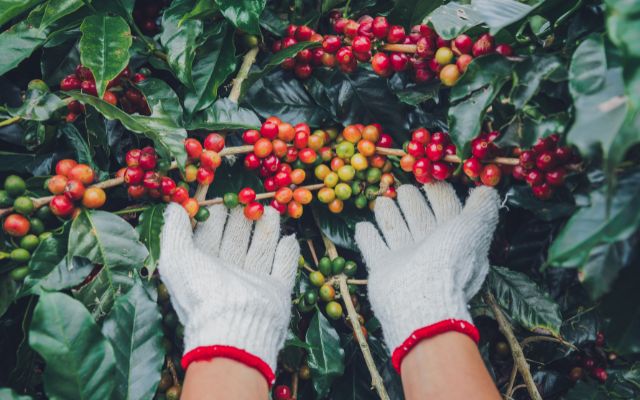Do Coffee Beans Grow On Trees?
Do coffee beans grow on trees? Yes, coffee beans grow on coffee plant. But do you know how it develops from coffee cherries bean to tree? Explore more here.

Do coffee beans grow on trees?
Yes, the coffee plant, a bush-like plant that can grow to be quite tall, is where coffee beans are produced (coffee farmers will usually keep them trimmed to around 5ft to keep them manageable). Bunches of cherries that contain both Arabica and Robusta coffee beans grow on these coffee trees.
How to grow coffee beans to tree?
There are two ways to grow coffee trees: growing from seeds or grafting. In our country the popular method is still nursery and growing from seeds.
2 types grow coffee
1. Growing from seed.
People will choose ripe coffee berries, remove the outer flesh by hand, then put the seeds in water to remove the flat seeds. Then people put good quality seeds in pots or on the ground for incubation.About 30-40 days after the seeds will germinate and about 6 months later they will be brought to the field to plant. After planting fixed in the ground, 3 years later the coffee tree will produce the first flower.
2. Branch grafting.
People will use a sharp knife to cut a young bud of a mature tree to graft into the main tree. The main tree is a tree about 1 year old. After grafting and planting fixed in the ground about 2 years later, the coffee tree will be harvested.Arabica coffee is a self-pollinating plant, so it can get seeds naturally. And Robusta is a cross-pollinated plant, so to avoid seed degeneration when breeding, we must be careful or it will affect the quality and purpose of planting.
Grow Coffee Instructions
Preparing to grow coffee beans
The nursery should use a large black plastic pot with the size of 16 x 25cm or 18 x 25cm. Available at nursery supply stores. It is not recommended to use smaller pots because they will not have enough nutrients (plants need to be incubated for 6 months before planting) and are prone to root curl.
Nursery soil should take top soil, loose, dry mixed with manure (or microbial fertilizer) + phosphorus. Mixing ratio is usually: 1 tortoise cart (wheelbarrow) of soil + 5kg of manure + 100g of phosphorus
Nursery pots should be lined up, 12 pots horizontally, vertically depending on the actual length for easy care later
Above and around it is necessary to plug poles to cover the net, use a specialized nursery nylon net
If you like coffee plants, do you know what plants suitable for coffee grounds?
Seed preparation and seed treatment
Coffee beans should be selected from good-quality trees in the coffee garden, or you can buy coffee seeds at reputable seed shops.
For Robusta coffee, it is recommended to choose high-yielding coffee varieties: TR4 coffee varieties, TR9 varieties, and dwarf green coffee varieties (Lam Dong TS5 coffee), these varieties have a favorable transmission rate to seedlings. more thanSeeds before incubation need to be treated by soaking in clear lime water (if the skin is still on) or warm water at 50-60 degrees Celsius for 6-8 hours to stimulate germination. Seeds after soaking should be washed with cold water. Remove black seeds, flat seeds…
Coffee bean incubation technique
- Prepare the soil bed: Use fine, loose topsoil that has been screened for garbage, plant roots, etc. to form a bed 15-20cm high, 1m-1m2 wide, you can mix sand or rice husks to increase porosity, seeds germinate will have straight roots. The location of the beds must be shaded, not letting the sun shine down directly. The bed must also be dry without standing water.
- Outside the edge of the bed, bricks and boards should be used to place them around to avoid erosion when watering and retain moisture better.
- Spread 1 layer of treated seeds on top of the bed, so that the seeds do not overlap, as tightly as possible.
- Continue to cover the seeds with a layer of fine soil or sand 1-2cm thick
- On the top, we cover with straw, rice husk, sawdust or nylon net (type used to shade the sun) to retain moisture and avoid eroding the seeds when watering.
- Use a misting can or an umbrella to water once every 1-2 days, always keeping the bed moist. Create good conditions for seeds to germinate. In case of cold weather, it is necessary to water with warm water of 60 degrees Celsius. The seeds will germinate faster
- After a few weeks, the seeds begin to germinate, rise from the bed, we can remove the layer of straw, rice husk, sawdust and continue watering to keep the plants moist.
- When the seeds begin to sprout, we proceed to remove the bricks around the bed, gently separate the plants from the bed
- Choose healthy, straight-rooted plants. Remove plants with 2 roots, curved roots, curved stems…
- Use water to wash off the sandy soil on the roots and proceed to plug the plants into the nursery
